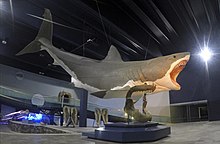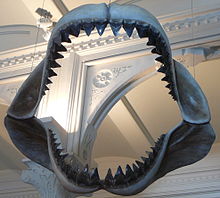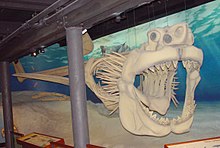Megalodon
![]()
The title of this article is ambiguous. For other meanings, see Megalodon (disambiguation).
The megalodon (Otodus megalodon, syn.: Megaselachus megalodon, Carcharocles megalodon or Carcharodon megalodon) is an extinct species of shark in the family Otodontidae, or possibly the mackerel sharks (Lamnidae), scientifically described by Louis Agassiz in 1835. The fossil record of this shark ranges from the upper Miocene to the Pliocene-Pleistocene boundary 3.6 or 2.6 million years ago and consists of worldwide tooth or (more rarely) vertebrate finds. This species probably preferred the euphotic zone of warm seas. With an estimated maximum length of 15.9 to 20.3 meters, O. megalodon was probably the largest shark species in Earth history. Characteristics include enormous body size and large, triangular teeth, which is why this species was previously assigned to the genus Carcharodon. However, more recent studies tend to suggest that O. megalodon was less closely related to the great white shark, and assign the animal to different genera (Carcharocles, Megaselachus, or Otodus, the former of which is the most common in scientific works, the latter the valid one today), all within the extinct family Otodontidae. Despite the sparse remains, numerous studies are concerned with the physique, biting power, and prey of this animal. The name is derived from Greek μέγας (megas) large and ὀδόν (odon) tooth.
Fossil record and distribution
The existence of the megalodon is documented by fossil teeth that have been dated to between 2 and 17 million years old. They have been found in Australia, Europe, Africa, India, Japan, South and North America, indicating a worldwide distribution. Some of these teeth are more than 18 cm long. Similar to today's great white shark, Otodus megalodon probably preferred coastal regions in warm seas. The teeth are most often found in sediments that indicate ocean depths of less than 200 m, though it is possible that O. megalodon also occurred in ocean depths of up to 300 m. Its huge teeth were used by Stone Age people for spearheads and the like. Usually only the teeth of cartilaginous fishes survive and allow conclusions to be drawn about the animal, whereas the calcified skeletal cartilage can hardly be preserved. Therefore, there are only a few vertebrae and bite marks on whale bones from Megalodon. The best preserved specimen (IRSNB 3121) is known from a vertebral column from the Miocene of Belgium. Almost 150 vertebrae could be assigned to it. The diameter of the vertebrae ranges from 55 to 155 mm. The specimen is estimated to be 9.2 m in size. The largest known vertebra that can be assigned to O. megalodon was found in Denmark and has a diameter of about 230 mm. Some prismatic cartilages from late Cenozoic strata may belong to O. megalodon, but this is controversial.

Tooth of a megalodon

16 meter long plastic living reconstruction of Megalodon, in the foreground a jawbone
Features
Teeth and jaws
O. megalodon had triangular teeth with finely serrated cutting edges and a V-shaped indented tooth root. While the anterior teeth are large and symmetrical, the posterior teeth are more asymmetrical with a slightly oblique crown. In addition to the anterior and posterior teeth, O. megalodon also had lateral teeth and intermediate teeth in the upper jaw. In the upper jaw, O. megalodon has four anterior teeth, two intermediate teeth, 14 lateral teeth, and eight posterior teeth. In the lower jaw, there are six anterior teeth, 16 lateral teeth, and eight posterior teeth. In some studies, only anterior and lateral teeth are distinguished. Lateral serrations at the root of the teeth (which are present in relatives of O. megalodon) are absent, though they are occasionally present in juveniles. Teeth are broad but not very thick. Based on the tooth size and proportions of a modern great white shark, a dentition has been reconstructed that would have been large enough to swallow an upright human. The dentition is estimated to be over 3 meters wide and over 2.5 meters high. The jaws were reconstructed by Gottfried and colleagues as larger, more robust, more massive, and with stronger muscles than those of the great white shark.
Vertebrae
Vertebrae of O. megalodon are rarely found, but 20 vertebrae from the Gram Formation (Upper Miocene, Denmark) allow insights into the vertebral anatomy of O. megalodon. The vertebral bodies were short and highly built. All vertebrae had calcified surfaces in the articular cavities. The vertebrae differed from those of the basking shark (which are often found in the same formations and are similar in size) in having thicker walls, a less elongate structure, and smaller holes in the middle. It is believed that the vertebral column of O. megalodon consisted of 190 to 200 vertebrae, which would make it significantly more vertebrae than that of the great white shark.
Size
There are different opinions about the size of O. megalodon. Earlier estimates ranged from 9 to 30 meters. The 30-meter figure was later (1994) considered untenable, and subsequent estimates used 12 to 18 meters as the range for the size of an adult megalodon. Michael Gottfried (1996) calculated the size of the largest known specimen at the time, based on a 168 mm tooth. The calculations are based on the assumption that the relationship between the height of the anterior teeth and the total length had similarities to that of a great white shark. This assumption is supported by the fact that great white sharks already have relatively large teeth and that O. megalodon had proportionally wider teeth than the great white shark. Therefore, proportionally longer teeth are unlikely. Gottfried gave a conservative figure of 15.9 meters and about 50 tons, a middle figure of 17 meters and 60 tons, and a generous figure of 20.2 meters and 103 tons. This method and the figures are relatively widely accepted. Using a comparable method, Kenshu Shimada arrives at body lengths of 14.2 to 15.3 meters in 2019, the latter value referring to the tooth also used by Gottfried in 1996. In Shimada's view, however, sizes over 15 meters were rarely reached.
An alternative method uses the width of the upper front teeth to calculate the size. It can be used to estimate the owner of a 12 centimeter wide tooth to be 16.5 meters in total length. The method is supported by the fact that the jaw girth (which is derived from the width of the largest tooth) is proportional to the size of the animal. This principle is applicable to most large sharks. Specimens less than 10.5 meters in body size are defined as juveniles and specimens less than 4 meters in size are defined as neonates. Gottfried suggests that males reached sizes of 10 to 14 meters, while females reached 13 to 17 meters, according to his data.
Originally, comparisons of teeth from different lithostratigraphic units suggested that the size of O. megalodon increased with time. However, a study from 2015 could not confirm this hypothesis using 544 O. megalodon teeth of all ages. Body length was calculated here using tooth height, based on great white sharks. The body length of the specimens ranged (according to the mentioned calculation) from 2.2 to 17.9 meters with an average value of about 10 meters. The highest average value is found in specimens from the late Miocene.
Physique
Almost nothing is known about the body structure, as nothing has been found except for some vertebrae and teeth. Nevertheless, there is a reconstructed skeleton, based on that of the great white shark. There, O. megalodon is depicted with a proportionally wider jaw and proportionally somewhat longer fins than today's great white shark; it is also much more powerfully built in the reconstruction.
Other researchers suspect that O. megalodon was more closely related to the sand tiger shark than to the great white shark and therefore looked more like it. Bretton Kent doubts this, however, because the physique of sand tiger sharks is designed for acceleration. To maintain swimming ability, such a large sand tiger shark would need proportionally much larger fins. They would be a hindrance to swimming because a lot of force would be required to move them. Therefore, Kent suggests that the only body shape that would be suitable for such a large shark would be one designed for energy-saving sustained speed. Kent suggests whale and basking sharks as the basis for the body shape. These have a sickle-shaped tail fin and a small anal fin. This body shape reduces the pulling force when swimming. Other large swimmers (great white sharks, mako sharks, spearfish and tuna) also have such features.
Allometric comparisons with several ecologically similar and behaviorally comparable recent representatives of mackerel sharks would suggest a cranial length of just over 4.65 meters for an approximately 16-meter-long specimen of O. megalodon, which would represent about 29% of the total length. The dorsal fin would be a good 1.62 meters high (10%) and 1.99 meters long (12%), while the total body height measured at and including the dorsal fin would be 4.53 meters (28%). The caudal fin, in turn, could have reached 3.85 metres in height (24%), while the pectoral fin would be slightly smaller at 3.1 metres. In the overall context of this reconstruction, O. megalodon would have a somewhat more compact and stocky physique than when compared purely to the great white shark.

Megalodon (grey and red) with a whale shark (purple), great white shark (green) and a human (black)

Jaw reconstruction of a megalodon, on display at the National Aquarium in Baltimore.

Jaw reconstruction of a megalodon, on display at the American Museum of Natural History.

Reconstructed O. megalodon skeleton. On display at the Calvert Marine Museum.
Questions and Answers
Q: What is the megalodon?
A: The megalodon was the largest shark of all time.
Q: What is the scientific name of the megalodon?
A: The scientific name of the megalodon is Otodus megalodon.
Q: When did the megalodon live?
A: The megalodon lived from the early Miocene to the Pliocene epochs, 23 to 3.6 million years ago (mya).
Q: Is the megalodon closely related to the present-day great white shark?
A: No, the megalodon is not closely related to the present-day great white shark.
Q: What was the size of megalodon's teeth?
A: Megalodon had teeth, which are among the largest ever found, over 18 cm (7.1 in) long.
Q: How long was the megalodon estimated to be?
A: Paleontologists estimate that the megalodon was up to 20 m (66 ft) long with an average length of 17 meters (56 feet).
Q: How much did the megalodon weigh?
A: The megalodon weighed up to 48-103 metric tons.
Search within the encyclopedia